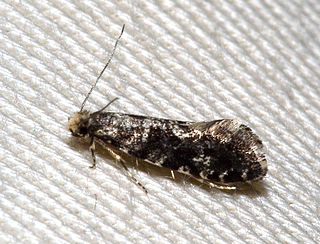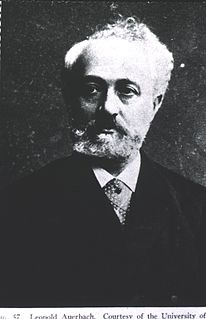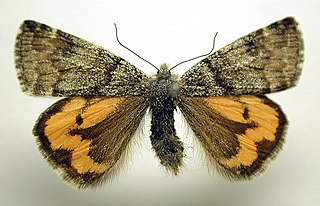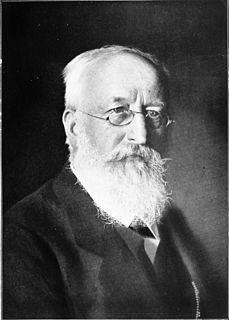
Lepidoptera is an order of insects that includes butterflies and moths. About 180,000 species of the Lepidoptera are described, in 126 families and 46 superfamilies, 10 percent of the total described species of living organisms. It is one of the most widespread and widely recognizable insect orders in the world. The Lepidoptera show many variations of the basic body structure that have evolved to gain advantages in lifestyle and distribution. Recent estimates suggest the order may have more species than earlier thought, and is among the four most speciose orders, along with the Hymenoptera, Diptera, and Coleoptera.

Moths are a paraphyletic group of insects that includes all members of the order Lepidoptera that are not butterflies, with moths making up the vast majority of the order. There are thought to be approximately 160,000 species of moth, many of which have yet to be described. Most species of moth are nocturnal, but there are also crepuscular and diurnal species.

The Arctiinae are a large and diverse subfamily of moths, with around 11,000 species found all over the world, including 6,000 neotropical species. This group includes the groups commonly known as tiger moths, which usually have bright colours, footmen, which are usually much drabber, lichen moths, and wasp moths. Many species have "hairy" caterpillars that are popularly known as woolly bears or woolly worms. The scientific name of this subfamily refers to this hairiness. Some species within the Arctiinae have the word tussock in their common name due to people misidentifying them as members of the Lymantriinae based on the characteristics of the larvae.

The Tortricidae are a family of moths, commonly known as tortrix moths or leafroller moths, in the order Lepidoptera. This large family has over 11,000 species described, and is the sole member of the superfamily Tortricoidea, although the genus Heliocosma is sometimes placed within this superfamily. Many of these are economically important pests. Olethreutidae is a junior synonym. The typical resting posture is with the wings folded back, producing a rather rounded profile.

Tineidae is a family of moths in the order Lepidoptera described by Pierre André Latreille in 1810. Collectively, they are known as fungus moths or tineid moths. The family contains considerably more than 3,000 species in more than 300 genera. Most of the tineid moths are small or medium-sized, with wings held roofwise over the body when at rest. They are particularly common in the Palaearctic, but many occur elsewhere, and some are found very widely as introduced species.

Prof Karl (Carl) Theodor Ernst von Siebold FRS(For) HFRSE was a German physiologist and zoologist. He was responsible for the introduction of the taxa Arthropoda and Rhizopoda, and for defining the taxon Protozoa specifically for single-celled organisms.

Leopold Auerbach was a German anatomist and neuropathologist born in Breslau.

The Batrachedridae are a small family of tiny moths. These are small, slender moths which rest with their wings wrapped tightly around their bodies.

Pterolonchidae is a small family of very small moths in the superfamily Gelechioidea. There are species native to every continent except Australia and Antarctica.
Theodor Emil Schummel was a German entomologist who specialised in Diptera. Schummel was a private tutor in Breslau. He was a member of Schlesische Gesellschaft für vaterländische Cultur a largely scientific society which received royal ratification in 1809 after the draft of its constitution was sent to the government in Königsberg and published many of his shorter scientific papers on insects in the society's journal Übersicht der Arbeiten und Veränderungen der Schlesischen Gesellschaft für Vaterländische Kultur, abbreviated Übers Arb. Ver. Schles. Ges. Vaterl. Kult.

Trichophaga tapetzella, the tapestry moth or carpet moth, is a moth of the family Tineidae. It is found worldwide.

Archiearis notha, the light orange underwing, is a moth of the family Geometridae. The species was first described by Jacob Hübner in 1803 and can be found in Europe.

August Assmann (1819-1898) was a German entomologist who specialised in fossil insects of Lepidoptera and Hemiptera.

Micropterigoidea is the superfamily of "mandibulate archaic moths", all placed in the single family Micropterigidae, containing currently about twenty living genera. They are considered the most primitive extant lineage of lepidoptera. The name comes from the Greek for mikros, little and pterux, a wing. The fossil record of the group goes back to the Middle-Late Jurassic with the earliest known species being Auliepterix from the Karabastau Formation in Kazakhstan.

A sloth moth is a coprophagous moth which has evolved to exclusively inhabit the fur of sloths and to use sloth dung as a substrate for the early stages of reproduction. Sloth moths include Bradypodicola hahneli, Cryptoses choloepi, Cryptoses waagei, Cryptoses rufipictus, and Bradypophila garbei.

A large number of arthropods are associated with sloths. These include biting and blood-sucking flies such as mosquitoes and sandflies, triatomine bugs, lice, ticks and mites. The sloth’s fur forms a micro-ecozone inhabited by green algae and hundreds of insects. Sloths have a highly specific community of commensal beetles, mites and moths.

WUWA was a building exhibition held in Breslau, Weimar Republic in 1929. Organized by the Silesian committee of the Deutsche Werkbund, close to the Scheitniger Park. Several local architects, mainly members of Werkbund, participated in the exhibition. 32 different types of buildings were presented to serve as "standards". The main focus was on simple, but not trivial architectonical form and functionality. All 32 buildings were built within a three-month period. Recreational areas were a part of this project, together with a wooden kindergarten which was supposed to show new architectural trends.
The following are the regional Lepidoptera lists by continent. Lepidoptera is the insect order consisting of both the butterflies and moths.

Maximilian Rudolph Standfuss was a German-Swiss entomologist specializing in Lepidoptera.

















